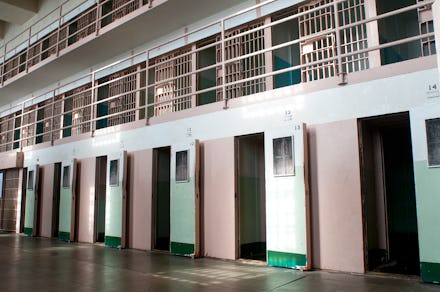America Has the Largest Prison Population in the World, But Not for the Reason You Think

Prison reform is having a moment.
A few years ago, it would have been difficult to fathom, but these days, modern-day debtors' prisons make national headlines and initiatives to reduce prison overcrowding count as major ballot measures. In public policy circles, one can hardly go a week without seeing some mention of Michelle Alexander's book The New Jim Crow: Mass Incarceration in the Age of Colorblindness. Especially in the wake of 2014's police killings, reappraising crime and punishment has become a minor national obsession. While there isn't a consensus on what is to be done, there's little disagreement that a country with 5% of the world's population but 25% of its prisoners is doing something wrong.
Central to the new scrutiny over America's incarceration system is the war on drugs. Alexander posits that the political and the criminal justice systems have used drug possession as a pretext for hollowing out the nation's black communities and filling up its prisons. Advocates for drug policy reform link staggeringly punitive sentencing practices for drug possession to the explosion of the country's prison population, which has multiplied five times over since former President Ronald Reagan took office in 1980. Among progressives, the standard solution to fixing mass incarceration is ending the war on drugs.
Unfortunately, it may not be that simple. John Pfaff, a professor at Fordham Law School who specializes in sentencing law and statistical analysis, argued in an interview with Slate last week that even a complete reversal in the war on drugs wouldn't end America's mass incarceration system. In fact, it would still leave the U.S. with more prisoners than any other country in the world.
The real causes of mass incarceration: Pfaff's interview teems with statistics that complicate the standard account of how and why people go to prison.
He acknowledges that drug-related offenses and exceptionally long sentencing practices contribute to mass incarceration, but explains that they can't account for the sheer enormity of the prison population.
Here are the sobering numbers from the interview: Only 17% of the state prison population — which, along with those held in local jails, constitutes 90% of all prisoners — are in prison "primarily for drug-related charges." The state prison population would only decrease from 1.5 million to 1.2 million if all those charges are dropped; the U.S. would still dwarf China, Russia and the rest of the global community with its prison population. Two-thirds of the people in state prisons are locked up for property or violent crimes.
This chart from the Prison Policy Initiative demonstrates just how much the prison population has grown over the past few decades:
So is America actually suffering from an overzealous war on property and violent crime? In a sense, yes.
Pfaff breaks down the prison population explosion into two eras. While a surge in the prison population between 1975 and 1991 can be explained at least in part by the dramatic rise in violent and property crime around that time, after 1991, the crime rate fell but the prison population continued to swell. (Lest you think that this is where drug offenders contributed to the increase, their percentage of the population peaked in 1990.)
Despite less crime, fewer arrests and the fact that, by one estimate based on northern and northwestern states, "only about 10% [of prisoners] serve more than about seven or eight years in prison," according to Pfaff, the prison population continued to grow. Pfaff points to a variable that rarely ever arises in popular conversation — trends in felony charges by district attorneys:
What appears to happen during this time—the years I look at are 1994 to 2008, just based on the data that's available—is that the probability that a district attorneys file a felony charge against an arrestee goes from about 1 in 3, to 2 in 3. So over the course of the '90s and 2000s, district attorneys just got much more aggressive in how they filed charges. Defendants who they would not have filed felony charges against before, they now are charging with felonies.
So why are district attorneys more likely to file charges when everything is better? Pfaff is uncertain. They are elected officials who stand to benefit from appearing tough on crime, but why would their practices escalate over time as crime declined? It will be interesting to see how other scholars in this policy realm contend with the theory.
Why it matters: None of this means that the war on drugs is of no consequence or that winding it down wouldn't be of use in winnowing down the prison population. But Pfaff's analysis suggests that reforming drug penalties is no silver bullet, and that advocates will need to reckon with deeper patterns in how American society has grown accustomed to dealing so aggressively with crime.
Reformers need not only to think about how the state overreacts to teens with marijuana but also how to deal sensibly with the manifestly violent. For those easily frightened by the specter of murderers wandering the streets, consider that some countries have succeeded in putting stringent caps on the amount of time someone can send behind bars and maintained extremely low crime and recidivism rates.
Mass incarceration is a massive challenge, and it's going to require a comparably ambitious path of soul-searching if it's to ever end.
h/t Slate
This post has been updated.